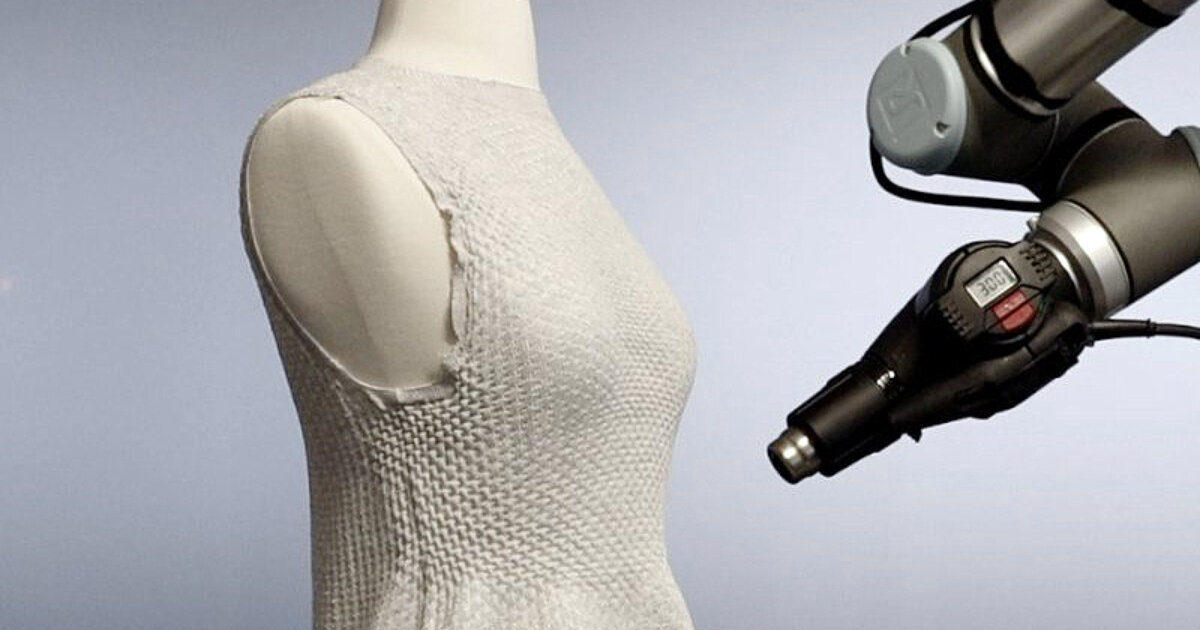Mit's robot arm can tailor a dress using computerized knitting and heat-activated yarns
- Select a language for the TTS:
- UK English Female
- UK English Male
- US English Female
- US English Male
- Australian Female
- Australian Male
- Language selected: (auto detect) - EN

Play all audios:

EXPLORING MIT’S 4D KNIT DRESS CREATED BY A ROBOT ARM MIT’S Self-Assembly Lab team develops the 4D Knit Dress, a new way to personalize a dress in any size using a six-axis ROBOT arm
typically used in the automotive industry, COMPUTERIZED KNITTING, and HEAT-ACTIVATED YARNS. Led by Sasha MicKinlay, a recent graduate of the MIT Department of Architecture, in collaboration
with fashion company Ministry of Supply, 4D Knit Dress can generate clothing that fits the wearer by sculpting the garment around their body and using a robot arm that blows dry the
heat-activated yarn to style the fabric. The resulting dress can also be altered after the wearer has used it for months. They can change the way it looks using the robot arm, computerized
design, and knitting, allowing the entire outfit to be reused. images courtesy of MIT’s Self-Assembly Lab | photo by Olivia Mintz Once the garment design is programmed into the robot arm, it
can quickly produce multiple dresses. The heat-activated yarns follow the robot’s sculpting instructions, such as pintucks, pleats, an empire waist, or a cinched waist. They get scrunched
up using heat and without needing any needles or sewing techniques. This enables the wearer to choose their own style or design that fits their body type and fashion taste. Sasha MicKinlay
helped produce these active yarns, created the concept design, developed the knitting technique, and programmed MIT SELF-ASSEMBLY LAB’S industrial knitting machine, the home to the
3D-PRINTING TECHNIQUE that can help produce pieces of furniture in a few minutes using liquid metal. the heat-activated yarns follow the robot’s sculpting instructions, such as pintucks, an
empire waist, or a cinched waist HEAT-ACTIVATED YARNS BUNDLE UP IN A SPECIFIC PART Danny Griffin, a current graduate student in architectural design, joins the team and translates the heat
activation process into a programmable robotic procedure. His role allows the MIT’s robot arm to be precise with its movement and application as it works on the 4D Knit Dress. The way it
works is that when the heat is applied, the fibers shorten, which results in the heat-activated yarns bundling up in a specific zone, shaping that area as if the robot were tailoring the
garment._ ‘There was a lot of trial and error to figure out how to orient the robot and the heat gun. The heat needs to be applied in precise locations to activate the fibers on each
garment. Another challenge was setting the temperature and the timing for the heat to be applied,’ _SAYS DANNY GRIFFIN. detailed view of the heat-activated yarns 4D KNIT DRESS CAN BE ALTERED
AND RESIZED AFTER USE Combating fast fashion is one of the solutions MIT’s 4D Knit Dress aims to provide. It’s not like the traditional ready-to-wear outfits with cut-and-sew processes in
the fashion industry since the project is only made in one piece. On top of that, the dress can also be tailored in order to adapt to changes in styles and tastes, _‘It may also be able to
absorb some of the size variations that retailers need to stock. Instead of extra-small, small, medium, large, and extra-large sizes, retailers may be able to have one dress for the smaller
sizes and one for the larger sizes. Of course, these are the same sustainability points that would benefit the consumer,’_ SAYS SASHA MICKINLAY. MIT’s robot arm can personalize the
clothing’s fit and size and modify the garment’s style Late last year, MIT’s Self-Assembly Lab team debuted the 4D Knit Dress at MINISTRY OF SUPPLY’S flagship store in Boston, complete with
the six-axis robot arm, which is typically used in manufacturing vehicles, working its way around a dress as customers watched. Gihan Amarasiriwardena, the co-founder and president of the
Ministry of Supply, says it was an opportunity to gauge interest and receive feedback from customers interested in trying the dress on. As of publishing the story, the team is looking into
working on more styles, looking into technical barriers that may need solving, and exploring whether the demand for the 4D Knit Dress is present. once the garment design is programmed into
the robot arm, it can quickly produce multiple dresses MIT’s 4D Knit Dress can be a new way to personalize a dress in any size using computerized knitting